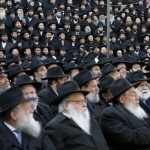Spiritual leadership – Tol’dot
 The haftarah describes the task of the kohen: “For the priest’s lips should keep knowledge, and they should seek Torah at his mouth, for he is the messenger of the Lord of Hosts” (Malachi 2:7).
The haftarah describes the task of the kohen: “For the priest’s lips should keep knowledge, and they should seek Torah at his mouth, for he is the messenger of the Lord of Hosts” (Malachi 2:7).
Much can be gleaned about the Jewish concept of religious leadership from the Hebrew epithets attached to the names of famous people.
To take only Biblical examples, there is “Avraham Avinu” – Abraham our Father; “Yosef HaTzaddik” – Joseph the Righteous; “Moshe Rabbenu” – Moses our Teacher; “Aharon HaKohen” – Aaron the Priest; “David HaMelech” – David the King; “Eliyahu HaNavi” – Elijah the Prophet, and so on.
In post-Biblical Judaism, leadership increasingly required intellectual eminence. A principle was formulated by Hillel, “An ignorant person cannot be pious”.
The Talmudic teachers were sometimes charismatics, even miracle workers; some were mystics; many were poets; all were people of piety; but it was by virtue of their learning that they were looked up to and respected.
There was a technical procedure of ordination which made a man a rabbi; the term means “my teacher”, though in some early generations there was also men who were of such national eminence that they were called rabban – “our teacher”.
The rabbi as student, teacher and judge, immersed in the tradition and responsible for its transmission to the people, was not a salaried professional. Talmudic rabbis earned their living from a whole range of occupations: they included blacksmiths, bootmakers, and even a gladiator.
The concept that the Torah should not be used as a means of livelihood was deeply entrenched; into God’s mouth were put the words, “Just as I gave you the Torah gratis, so must you give the Torah without charge”.
It was not until the Middle Ages that the salaried rabbinate developed, and only because persecution, oppression and expulsion were undermining the stability of the traditional system, and the Torah was in danger of being lost if its teachers found it so hard to make a living, that they had insufficient time to study and teach.
The 18th century saw a new type of spiritual leader evolve the Tzaddik (Righteous One), later called the Rebbe.
The masses of the people in eastern Europe felt alienated by rabbinic intellectuality. In times of persecution when there was so much suffering and distress, even the unlearned needed love, support and reassurance.
The result was the Chassidic movement which spread the simple values of religious emotion and ecstasy in the presence of God.
The Chassidic leader was sometimes learned, and sometimes not, but his influence was spiritual, emotional and pastoral more than intellectual.
Martin Buber wrote, “The Tzaddikim offer us a number of religious personalities of a vitality, a spiritual strength, a manifold originality such as never, to my knowledge, appeared together in so short a time span in the history of religion”.
Between Rabbi and Rebbe and their respective followers developed an era of prolonged and often profound conflict.
The Chassidic group, which spread widely through eastern Europe, accused the Mitnagdim (“Opponents”) of missing the true essence of religion. The Mitnagdim objected to the Chassidim neglecting Torah study and making the Rebbe almost an idol.
The conflict continued until the two groups realised they were both threatened by the secularist enlightenment of the nineteenth century and eventually a modus vivendi was reached.



